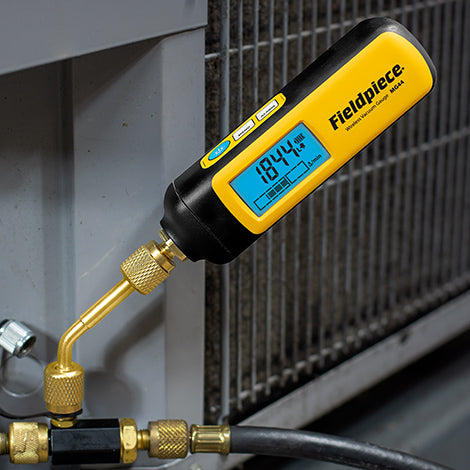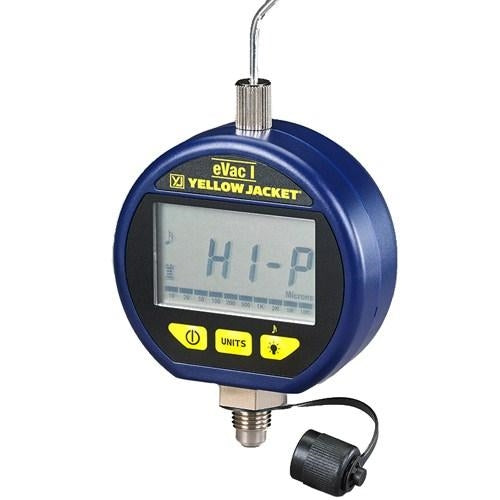
Vacuum Gauges: Enhancing HVAC Precision
HVAC systems, like any complex machinery, have many hidden heroes that keep them operating smoothly. One of these unsung warriors in maintaining efficient and reliable HVAC operations is the vacuum gauge. This humble device may not be the first thing that comes to mind when you think about HVAC systems, but its influence is massive. It's high time we shed some light on this often overlooked, yet powerful, tool in the HVAC technician's arsenal.
The ABCs of Vacuum Gauges
Before we delve into the nuts and bolts of how vacuum gauges work in HVAC systems, let's start with the basics. What exactly is a vacuum gauge?
In the simplest terms, a vacuum gauge measures pressure. But not just any pressure. Vacuum gauges specifically measure pressures lower than atmospheric pressure, making them an essential part of any HVAC technician's toolkit.
To fully grasp the role of vacuum gauges in HVAC systems, you need to understand that HVAC operations are not just about heating or cooling air. They're also about air movement and the pressures that drive this movement. Vacuum gauges help technicians monitor these pressures, ensuring the systems perform as efficiently and effectively as possible.
How Vacuum Gauges Work
Vacuum gauges come in different types, but the most commonly used in HVAC applications are the digital thermistor vacuum gauge and the bourdon vacuum gauge. The former is prized for its accuracy, especially in very low-pressure measurements, while the latter is typically more robust and less sensitive to contamination.
Whichever type is used, the vacuum gauge operates based on a simple principle: it compares the pressure in the HVAC system with a known reference pressure (usually atmospheric pressure), and then provides a reading of the difference. This information is crucial in both setting up HVAC systems and diagnosing any issues that might arise.
Benefits of Vacuum Gauges in HVAC Systems
Now that we've covered the mechanics, let's move onto the benefits vacuum gauges bring to HVAC systems.
-
System Efficiency: By helping technicians monitor and adjust the pressure within HVAC systems, vacuum gauges contribute significantly to system efficiency. An HVAC system with optimally balanced pressures consumes less energy and provides more effective heating and cooling.
-
Preventive Maintenance: Regular use of vacuum gauges can help spot problems before they become serious issues. For instance, a gradually increasing pressure reading might signal a slow refrigerant leak, allowing for early intervention.
-
Quality Control: When installing new HVAC systems, vacuum gauges play an important role in ensuring the system is properly evacuated and prepared for refrigerant charging. A vacuum gauge provides a quantifiable measure of the vacuum level, assuring the quality of the installation.
-
Problem Diagnosis: In case of system failures, vacuum gauges can provide valuable clues to the underlying issue. For example, a sudden drop in vacuum level might indicate a significant leak or blockage in the system.
Harnessing the Power of Vacuum Gauges
Having understood the importance of vacuum gauges in HVAC systems, it's essential to know how to harness their power effectively.
A fundamental aspect is knowing when and how to use the vacuum gauge. During installation of a new system, the vacuum gauge should be used after the system is assembled but before charging it with refrigerant. This helps ensure any contaminants or moisture are adequately removed from the system, which could otherwise impede performance and cause long-term damage.
When it comes to system maintenance, it's a good idea to use the vacuum gauge as part of regular inspections, even when the system seems to be functioning perfectly. As already discussed, this can help detect issues before they become more severe and expensive to repair. For instance, if the vacuum gauge shows a consistently high vacuum level, it might mean the system is low on refrigerant. On the other hand, a very low vacuum level could indicate a blockage in the system, such as a clogged filter or condenser coil.
Another essential aspect of using vacuum gauges effectively is interpreting the readings correctly. This requires understanding the pressure scales typically used with vacuum gauges. These are typically either Torr, millibar, or inches of mercury (inHg), with 1 Torr being approximately equivalent to 1 millibar, and 1 inHg being approximately 25.4 millibar. A vacuum gauge reading of 0 in these scales means the pressure is the same as atmospheric pressure, while a negative reading means the pressure is lower than atmospheric.
Lastly, it's important to remember that vacuum gauges are precision instruments and need to be handled and maintained properly. This includes regular calibration, careful handling to avoid physical shocks, and protection from contaminants. In particular, vacuum gauges used in HVAC applications should be kept away from oil and refrigerant vapors, which can contaminate the sensor and lead to inaccurate readings.
The Future of Vacuum Gauges in HVAC Systems
The world of HVAC is evolving rapidly, with advances in technology continually enhancing system efficiency and reliability. And vacuum gauges are no exception to this trend. Today's vacuum gauges are not only more accurate and reliable than their predecessors, but they are also becoming smarter.
Modern vacuum gauges often incorporate features such as digital displays, data logging, and even wireless connectivity. This allows for easier reading and interpretation of measurements, as well as integration with other diagnostic tools. For example, some vacuum gauges can be connected to a smartphone app, which can provide real-time pressure readings, historical data analysis, and even alerts when the vacuum level goes out of a specified range.
Such advances are making vacuum gauges an even more powerful tool in the hands of HVAC technicians, enabling them to ensure our HVAC systems keep humming along efficiently and reliably.
Final Thoughts
In conclusion, vacuum gauges are an indispensable tool in the world of HVAC systems. They play a pivotal role in ensuring system efficiency, preventive maintenance, quality control, and problem diagnosis. As technology continues to evolve, the capabilities of these humble devices are expanding, making them an even more vital part of the HVAC toolkit.
Whether you're an HVAC professional looking to optimize your services or a homeowner wanting to understand more about your HVAC system, appreciating the value of vacuum gauges can go a long way. After all, in the complex ecosystem of HVAC systems, every component, no matter how small or unassuming, has a role to play. And in the case of vacuum gauges, that role is more significant than you might think.
In the end, it's not just about unleashing the power of vacuum gauges. It's about leveraging this power to provide better, more efficient, and more reliable HVAC systems for everyone. And that's a goal worth striving for.




